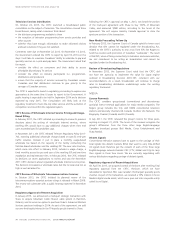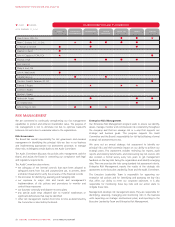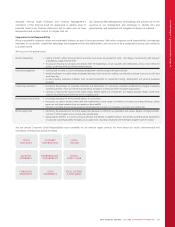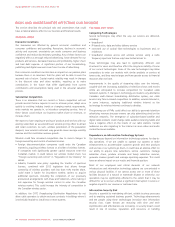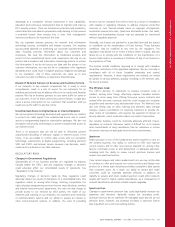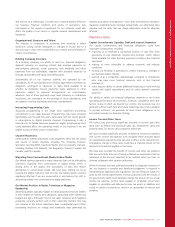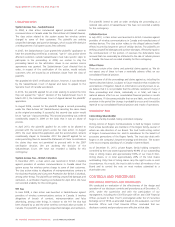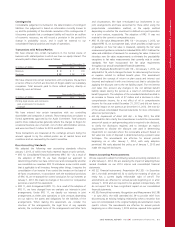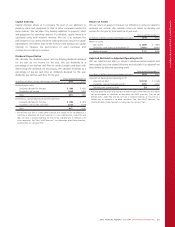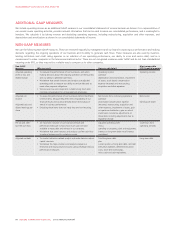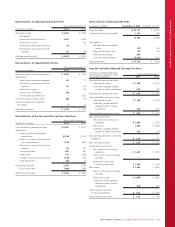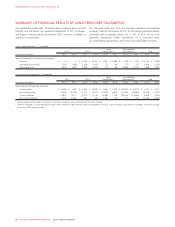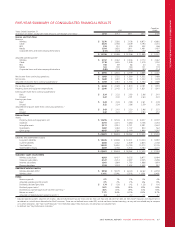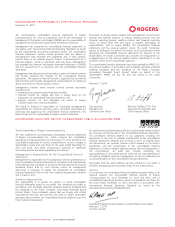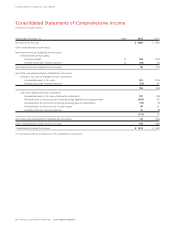Rogers 2013 Annual Report Download - page 84
Download and view the complete annual report
Please find page 84 of the 2013 Rogers annual report below. You can navigate through the pages in the report by either clicking on the pages listed below, or by using the keyword search tool below to find specific information within the annual report.
MANAGEMENT’S DISCUSSION AND ANALYSIS
on an annual basis or more often if events or circumstances warrant. A
cash generating unit is the smallest identifiable group of assets that
generates cash inflows that are largely independent of the cash inflows
from other assets or groups of assets. Goodwill and indefinite life
intangible assets are allocated to cash generating units (or groups of
cash generating units) based on the level at which management
monitors goodwill, which is not higher than an operating segment. The
allocation involves significant estimates of future cash flows, estimated
periods of use, applicable discount rates and considerable management
judgment, and is made to cash generating units (or groups of cash
generating units) that are expected to benefit from the synergies of the
business combination. If key estimates differ unfavourably in the future,
we could experience impairment charges that could decrease net
income. We did not record an impairment charge in 2013 since the
recoverable amounts of the cash generating units exceeded their
carrying values. In 2012, we recorded an impairment charge of $80
million related to certain Media assets, due to the challenging economic
conditions, weakening industry expectations and a decline in
advertising revenues.
Financial Instruments
The fair values of our Derivatives are recorded using an estimated
credit-adjusted mark-to-market valuation. If the Derivatives are in an
asset position (i.e., the counterparty owes Rogers), the credit spread for
the bank counterparty is added to the risk-free discount rate to
determine the estimated credit-adjusted value. If the Derivatives are in a
liability position (i.e., Rogers owes the counterparty), our credit spread is
added to the risk-free discount rate. The estimated credit-adjusted value
of Derivatives is affected by changes in credit spreads between us and
our counterparties.
Income and Other Taxes
We make income and other tax provisions based on information
currently available in each of the jurisdictions in which we operate.
While we believe we have paid and provided for adequate amounts of
tax, our business is complex and significant judgement is required in
interpreting tax legislation and regulations and estimating future levels
of taxable income. Our tax filings are subject to audit by the relevant
government revenue authorities and the results of the government
audit could materially change the amount of our actual income tax
expense, income taxes payable or receivable, other taxes payable or
receivable and deferred income tax assets and liabilities and could, in
certain circumstances, result in the assessment of interest and penalties.
Pension Benefits
When we account for defined benefit pension plans, assumptions are
made in determining the valuation of benefit obligations. Assumptions
and estimates include the discount rate, the rate of compensation
increase and the mortality rate. Changes to these primary assumptions
and estimates would affect the pension expense, pension asset and
liability and other comprehensive income. Changes in economic
conditions may also have an impact on our pension plan because there is
no assurance that the plan will be able to earn the assumed rate of
return. Market-driven changes may also result in changes in the discount
rates and other variables that would require us to make contributions in
the future that differ significantly from the current contributions and
assumptions incorporated into the actuarial valuation process.
The table below shows what the impact of an increase or decrease in
the primary assumptions and estimates on our accrued benefit
obligation and pension expense for 2013 would be:
(In millions of dollars)
Accrued benefit
obligation at end
of fiscal 2013
Pension
expense
fiscal 2013
Discount rate 5.10%4.50%
Impact of: 0.5%increase $ (105) $ (11)
0.5%decrease 120 13
Rate of compensation increase 3.00%3.00%
Impact of: 0.25%increase $ 14 $ 3
0.25%decrease (14) (2)
Mortality rate
Impact of: 1 year increase $ 26 $ 4
1 year decrease (27) (3)
Stock-Based Compensation
Stock Option Plans
Our employee stock option plans attach cash-settled share appreciation
rights (SARs) to all new and previously granted options. The SARs
feature allows the option holder to elect to receive in cash an amount
equal to the intrinsic value, instead of exercising the option and
acquiring Class B Non-Voting shares.
We measure stock-based compensation to employees at fair value. We
determine fair value of options using our Class B Non-Voting share
price and option pricing models, and record all outstanding stock
options as liabilities. The liability is marked-to-market in each period and
is amortized to expense using a graded vesting approach over the
period when employee services are rendered, or over the period to the
date an employee is eligible to retire, whichever is shorter. The expense
in each period is affected by the change in the price of our Class B Non-
Voting shares during the life of the option.
Restricted Share Unit (RSU) Plan
We record outstanding RSUs as liabilities, measuring our liabilities and
compensation costs based on the award’s fair value, and recording it as
a charge to operating costs over the vesting period of the award. If the
award’s fair value changes after it has been granted and before the
settlement date, we record the resulting changes in the liability as a
charge to operating costs in the year that the change occurs. The
payment amount is established as of the vesting date.
Deferred Share Unit (DSU) Plan
We record outstanding DSUs as liabilities, measuring our liabilities and
compensation costs based on the awards’ fair values at the grant date.
If an award’s fair value changes after it has been granted and before
the settlement date, we record the resulting changes in our liability as a
charge to operating costs in the year that the change occurs. The
payment amount is established as of the exercise date.
80 ROGERS COMMUNICATIONS INC. 2013 ANNUAL REPORT


